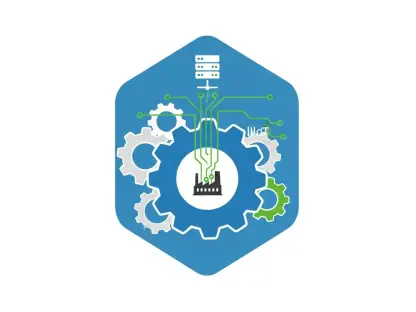In today’s hyper-connected industrial landscape, the manufacturing sector stands as a prime target for cyber threats, with ransomware attacks and supply chain disruptions becoming alarmingly common, exposing vulnerabilities that can lead to staggering financial losses. High-profile breaches at companies like Nucor and Masimo, coupled with countless smaller incidents, have laid bare the fragility of an industry where even a brief production halt can be devastating. Despite the growing urgency to safeguard operations, many manufacturers find themselves unable to transform well-intentioned cybersecurity strategies into robust, actionable defenses. This persistent struggle raises critical questions about the gap between planning and execution, leaving the sector exposed to relentless digital adversaries. Delving into recent survey data and real-world challenges, this exploration seeks to uncover the root causes behind these shortcomings and shed light on why cyber resilience remains elusive for so many in manufacturing.
Key Challenges in Cyber Preparedness
The Preparedness Paradox
A striking contradiction exists within the manufacturing industry when it comes to cybersecurity readiness, as evidenced by a global survey from Semperis showing that 95% of manufacturing and utilities organizations claim to have comprehensive cyber crisis response plans in place. However, the reality on the ground tells a different story, with over half of these organizations experiencing at least one high-impact cyber incident in the past year. Even more telling, 80% were compelled to activate their crisis plans in response to such events. This discrepancy highlights a fundamental flaw: the mere existence of a plan does not equate to effective preparedness. Cybercriminals exploit these weaknesses with precision, often disrupting production lines and sending shockwaves through intricate supply chains. The numbers suggest that while the industry may feel equipped on paper, the practical application of these strategies falls short when faced with real-world threats, leaving many scrambling to mitigate damage after the fact.
Beyond the statistics, the preparedness paradox reveals deeper systemic issues that undermine confidence in crisis response mechanisms across the sector. Many organizations overestimate their capabilities, assuming that documented plans are sufficient to weather a storm. Yet, when tested by sophisticated attacks like ransomware, these plans often fail to account for the speed and complexity of modern cyber threats. The high activation rate of crisis protocols—80% of respondents needing to deploy them—indicates not just the frequency of incidents but also a lack of proactive measures to prevent or contain them early. This reactive stance can lead to prolonged downtime, reputational harm, and financial strain, particularly in an industry where every minute of halted production translates to significant losses. Addressing this paradox requires a shift from theoretical planning to dynamic, battle-tested strategies that can adapt to evolving risks.
Communication Breakdowns
One of the most glaring obstacles to cyber resilience in manufacturing lies in the frequent breakdowns in communication during a crisis, a problem exacerbated by the industry’s sprawling, distributed operations. With facilities often scattered across regions and reliant on vast supplier networks, coordinating a unified response to a cyberattack becomes a daunting task. When ransomware or other threats strike, standard communication tools like email can be rendered unusable, leaving teams disconnected at the most critical moments. Without secure, alternative channels in place, stakeholders struggle to assess the scope of an attack, share vital information, or prioritize recovery efforts. This lack of coordination can transform a containable incident into a full-scale operational disaster, amplifying both the duration and cost of recovery for manufacturers already under pressure to maintain uptime.
Further compounding the issue is the absence of standardized communication protocols across the diverse entities involved in manufacturing ecosystems, from internal departments to external partners. Many organizations fail to anticipate how cyberattacks can sever traditional lines of contact, leaving decision-makers isolated and unable to act swiftly. The distributed nature of the industry means that a single breach at one facility can ripple outward, affecting suppliers and customers alike, yet few have invested in resilient, unified systems to maintain connectivity under duress. The result is often a chaotic response, where delays in sharing critical updates or instructions lead to missed opportunities for containment. Tackling this vulnerability demands not just technological solutions but a cultural commitment to prioritizing secure, reliable communication as a cornerstone of crisis management in manufacturing.
Operational Gaps in Crisis Response
The Practice Deficit
A significant barrier to effective cyber resilience in manufacturing is the lack of regular practice and updates to crisis response plans, a shortfall that leaves many organizations unprepared for real-world threats. According to recent data, only 56% of manufacturing and utilities organizations update their playbooks on a monthly or quarterly basis, a rate that lags behind the cross-industry average of 72%. This infrequent revision means that strategies often fail to reflect the latest threat landscapes or technological advancements, rendering them obsolete when a crisis emerges. Moreover, even when updates occur, the scope of training and simulations tends to be narrow, often focusing solely on IT teams while neglecting other critical functions. This limited approach undermines the ability to respond holistically, as cyberattacks frequently impact areas beyond technology, such as operations and customer relations.
Equally troubling is the exclusion of key non-technical stakeholders from crisis simulations, which further widens the readiness gap in the manufacturing sector. Only about 35% of organizations involve legal teams in exercises, 37% include business continuity personnel, and 43% engage disaster recovery staff. This oversight means that vital perspectives—such as compliance risks, financial reporting challenges, or employee safety concerns—are often ignored during planning. When a real attack occurs, the absence of these voices can lead to missteps, like failing to address regulatory obligations or underestimating the broader business impact. Building resilience requires comprehensive, whole-of-business practice that simulates real-world pressure and fosters coordination across departments. Without this, teams are left to improvise during high-stakes situations, a risky proposition in an industry where errors can halt production and incur massive costs.
Compliance vs. Resilience
Many cyber crisis plans in manufacturing are crafted with a focus on compliance rather than genuine resilience, a misstep that leaves organizations vulnerable to the unpredictable nature of modern threats. These strategies often prioritize meeting regulatory requirements or industry standards over addressing the specific operational realities of the sector, such as the critical need for uptime and the complexity of interconnected systems. As a result, plans may check all the necessary boxes on paper but fail to provide actionable guidance when an attack disrupts production. This disconnect is evident in the high frequency of incidents despite widespread plan adoption, suggesting that a compliance-driven mindset does little to prepare teams for the chaos of a real-world cyber event. True resilience demands a shift toward strategies that are tailored to the unique challenges of manufacturing.
Additionally, the lack of realistic, operationally grounded exercises further erodes the effectiveness of these plans, as many tabletop simulations are treated as mere formalities rather than opportunities to build critical skills. Instead of replicating the intense pressure of an actual crisis, these drills often remain superficial, failing to test the adaptability of teams or the integration of cross-functional responses. In manufacturing, where a single hour of downtime can derail entire supply chains, such shortcomings are particularly costly. Plans must go beyond static documentation to incorporate dynamic scenarios that mirror the sector’s dependencies and risks. By focusing on resilience over compliance, manufacturers can develop “muscle memory” for crisis response, ensuring that when threats materialize, teams are equipped to act decisively rather than react in disarray to unfolding events.
Human and Systemic Vulnerabilities
The Human Factor
At the heart of manufacturing’s struggle with cyber resilience lies the human element, a factor often overlooked in favor of technological solutions but one that plays a pivotal role in crisis outcomes. Communication gaps, fueled by inconsistent or outdated tools, frequently derail response efforts, especially when standard channels are compromised during an attack. Beyond technology, the lack of adequate training across all levels of an organization means that employees may not fully understand their roles or the protocols to follow in a crisis. This uncertainty can lead to hesitation or errors at critical junctures, prolonging recovery times and escalating damage. In a sector where precision and speed are paramount, these human-centric failures highlight the need for ongoing education and clear, accessible guidelines that empower staff to act confidently under pressure.
Moreover, the human factor extends to the coordination challenges inherent in manufacturing’s complex, multi-stakeholder environments, where miscommunication can have cascading effects. Suppliers, contractors, and internal teams must align seamlessly during a cyber incident, yet many organizations lack the frameworks to ensure this happens. Without regular drills that include all relevant parties, misunderstandings or delays become inevitable, often turning a localized issue into a widespread disruption. Addressing these vulnerabilities requires a cultural shift, one that prioritizes people as much as systems. Investing in secure communication platforms and comprehensive training programs can bridge these gaps, ensuring that human responses are as robust as technological defenses. Only by recognizing and tackling these weaknesses can the industry build a workforce ready to navigate the unpredictable terrain of cyber threats.
Systemic Risks
The manufacturing sector’s reliance on uptime and intricate supply chains creates systemic risks that magnify the impact of cyber incidents, setting it apart from other industries. A single breach can halt production across multiple facilities, delay deliveries, and disrupt customer commitments, with costs piling up by the hour. The interconnected nature of modern manufacturing systems—where operational technology often integrates with IT networks—means that a vulnerability in one area can quickly spread, exposing entire ecosystems to attack. This heightened exposure is compounded by the sector’s dependence on just-in-time logistics, leaving little room for error when a crisis strikes. As cybercriminals increasingly target these dependencies, the stakes for resilience grow exponentially higher, demanding strategies that account for the full scope of systemic fragility.
Equally concerning is the frequency of high-impact incidents, with 51% of surveyed organizations experiencing at least one major attack and 20% facing multiple disruptions in a single year. These figures underscore that cyber threats are not hypothetical but an ever-present reality for manufacturers, where the fallout often extends beyond financial loss to include safety risks and regulatory penalties. The distributed structure of the industry further complicates recovery, as coordinating across geographies and partners adds layers of difficulty to an already tense situation. Mitigating these systemic risks requires a holistic approach, mapping out critical dependencies and prioritizing the protection of key assets. By embedding resilience into the very fabric of operations, manufacturers can better withstand the inevitable assaults on their digital and physical infrastructure, safeguarding both profitability and stability.
Building a Path to True Resilience
Lessons from Past Struggles
Reflecting on the challenges faced, it becomes evident that the manufacturing sector has long grappled with a disconnect between cyber crisis planning and execution, as frequent high-impact incidents expose the limitations of static strategies. Communication failures have often paralyzed response efforts, leaving teams isolated when attacks sever traditional channels. Similarly, the lack of regular updates and inclusive training has hindered preparedness, with many plans growing outdated or irrelevant to real-world pressures. These struggles paint a clear picture: resilience demands more than documentation—it requires adaptability and coordination. Manufacturers who overlook these lessons pay a steep price, with downtime and cascading disruptions serving as harsh reminders of the gaps in their defenses during critical moments of crisis.
Steps Toward a Stronger Future
Looking ahead, actionable steps emerge as essential for bridging the gap between preparation and resilience in manufacturing. Developing operationally realistic plans tailored to the sector’s unique needs—mapping system dependencies and defining cross-departmental roles—stands out as a priority to ensure readiness for complex threats. Establishing secure, standardized communication tools, tested regularly for reliability, is equally critical to maintain connectivity during crises. Furthermore, whole-of-business simulations that include all stakeholders, from IT to legal and executive teams, prove vital for building familiarity and reducing improvisation under stress. By committing to these measures, the industry can transform cybersecurity from a theoretical exercise into a practical shield, equipping itself to face inevitable challenges with confidence and minimizing the devastating impact of future cyber incidents.









